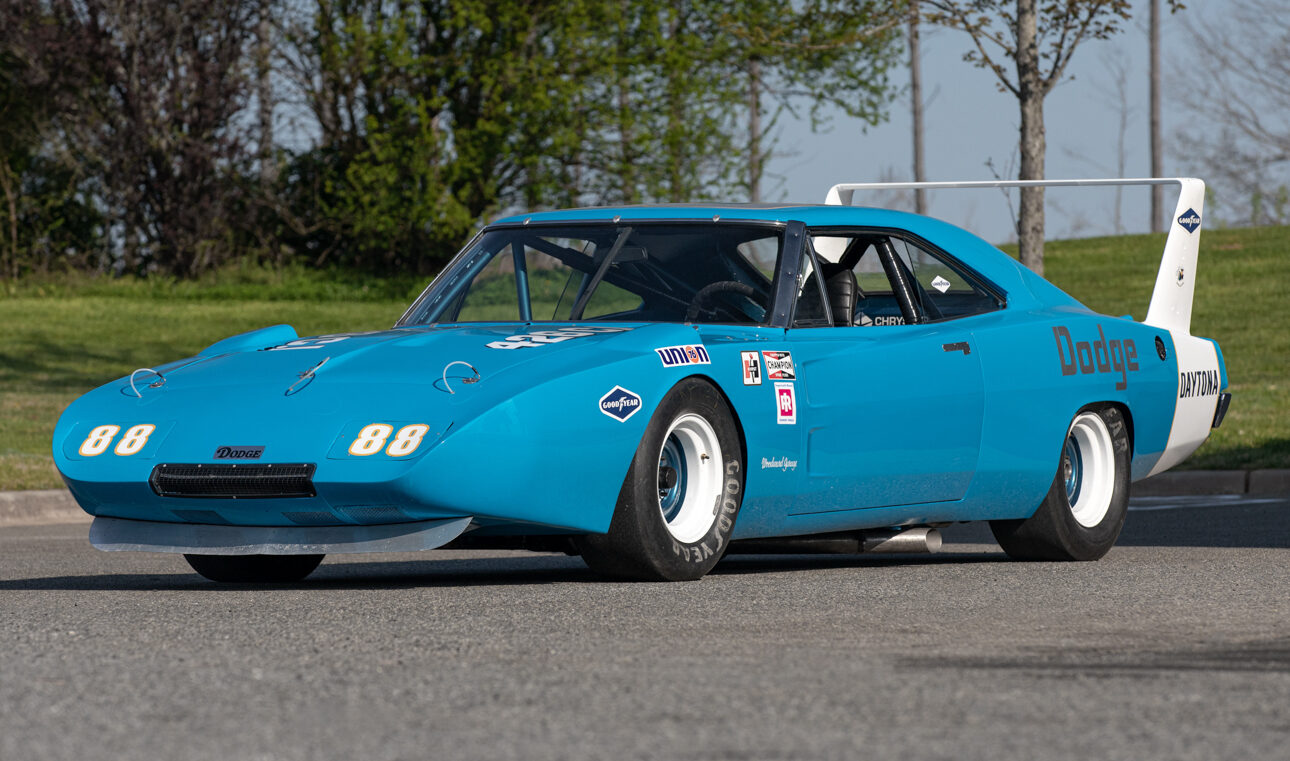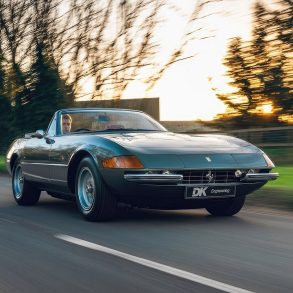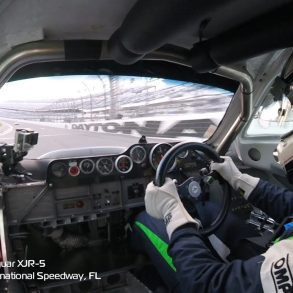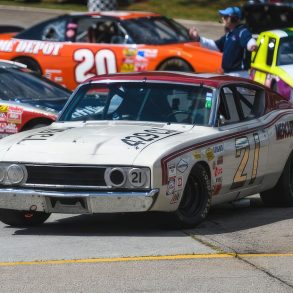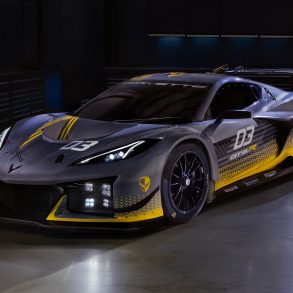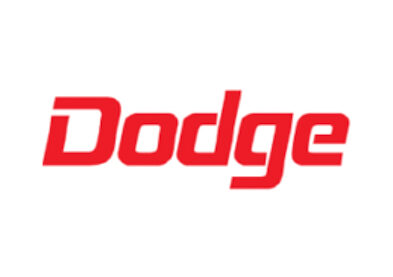

The Hemi-engine was packaged into production Dodge Charger and Plymouth Satellite bodyshells and race prepared by the shops of Ray Nichels in Highland, Indiana. In race trim, Chrysler’s NASCAR stock cars weighed in at 3800-lbs. and featured adjustable torsion-bar suspension with twin shock absorbers at the front and a Chrysler live axle with floating hubs at the rear, supported by heavy-duty leaf springs and twin shock absorbers on either side. The Hemi-engine’s 650 angry horses were transmitted to the rear axle via a standard Chrysler 833 4-speed as used in the company’s heavy truck line.

Birth of the Aerowar
In order to fully appreciate the Chrysler Aerocars, it is important to understand the events that led to their creation. Up to the late ’60s, NASCAR had managed to remain a relatively low-tech series with the same cars being raced that could be bought off the showroom floor. However, major manufacturers like Ford, General Motors and Chrysler had seen the power of “Win on Sunday, sell on Monday” and were now throwing tremendous amounts of engineering know-how and money towards winning stock car races and the NASCAR championship. From this hotbed of competition, a war of sorts broke out between the two dominant forces of the day, Ford and Chrysler. This came to be known as the “Aerowar.”
The opening shots of the Aerowar occurred in 1967, when Richard Petty dominated the NASCAR Championship driving his boxy, 426-cu.in. Hemi-powered Plymouth Satellite GTX to a remarkable 27 wins out of 49 races. For 1968, Chrysler entered a revised version of the Dodge Charger and the Plymouth Satellite into NASCAR competition. Though not revolutionary, the new designs appeared sleeker and more streamlined than the previous year’s championship winner. However, on the other side of the trenches, Ford knew that if it was going to be even remotely competitive in ’68, it was going to have to make major improvements to its under-powered, Ford Fairlane-line racecars. Since Ford’s conventional tunnel-port 427 motor was no match for the powerful Chrysler Hemi, Ford looked for the “unfair advantage” by making major inroads into the aerodynamics of its cars. Ford’s new sleek, fastback design dramatically improved performance without the need for increased horsepower. The result was a walkover – with Ford handily winning the ’68 NASCAR championship.
Earlier in the ’68 season, Chrysler engineers began to take a hard look at why their cars were being trounced by the underpowered Fords. Mechanically, the Charger and Satellite were reliable and enjoyed one of the most powerful engines of its day. Upon careful examination, however, the Chrysler engineers determined two major areas where their cars were aerodynamically at a disadvantage. The first problem area was the Charger’s recessed grill, which was creating a tremendous amount of drag and lift at the front end. The other problem was the rear window area, which appeared from the side to be an aerodynamically efficient fastback design, but was in fact two hollow C-pillars flowing to the back with a near-vertical back window nested in the center. With these problem areas discovered, Chrysler engineer John Pointer began sketching cures for the aerodynamic deficiencies. These cures included a narrowed-and-sealed grill insert to deflect air around the car’s nose, as well as a sheet metal cover over the C-pillars to create a true fastback design at the rear. These changes were tested at the Wichita State University wind tunnel and proved to be a significant improvement over the previous design. With this data in hand, Chrysler executives then approved the production of 500 street-going versions, which would be the minimum production number necessary to qualify the new design for NASCAR competition. This new design for 1969 was renamed the Charger 500.
While the Charger was modified and improved for the ’69 season, Chrysler executives opted not to modify the Plymouth variant, the Road Runner – thus rendering it an uncompetitive “lame duck” for the ’69 season. This decision did not sit well with Plymouth stalwart Richard Petty, who had brought so much success to the Chrysler division. Petty threw down the gauntlet and insisted that for him to remain with Chrysler, he would have to switch over to the new Dodge. Chrysler called King Richard’s bluff, directing him to race the uncompetitive Plymouth. Much to their dismay, he made good on his threat and walked. Not only did he walk, he walked right over and joined the enemy at Ford! This defection was a terrible blow to Chrysler, but not half as terrible as the blow they would receive at the 1969 season opening race at Daytona.
While Chrysler had been busy improving the Charger, Ford had created significantly improved versions of the Fairlane and Montego, known as the Torino Talladega and the Cyclone Spoiler II. These new designs were penned by famed stylist Larry Shinoda and constructed by famed racecar builders Holman & Moody. With drivers like Richard Petty and Cale Yarborough, the Ford juggernaut easily won the season opener at Daytona and continued to dominate throughout the majority of the ’69 season, much to the dismay of the Chrysler executives.

In response to this embarrassing battle loss, the Chrysler engineering team went back to the drawing board – and back to the wind tunnel – to wrench more aerodynamic efficiency from the Charger 500 before the end of the ’69 season. Again, John Pointer worked on the project, this time with the help of Dodge engineer Bob Marcell. As before, the airflow over the nose and the rear deck were determined to be the problem. What was needed were more drastic measures. The first change was to create an enclosed and pointed nose cone to allow smooth penetration of the oncoming airflow. While the new design did create smoother penetration, it also created significant lift due to much of the airflow being diverted underneath the car. So a sizable chin spoiler was added to counteract the lift. This new design created over 200 lbs. of front-end downforce when tested in the Wichita wind tunnel.

Turning their attention to the rear of the car, the design team determined that in order to balance the tremendous downforce now made at the nose of the car, they would have to add some type of a rear wing. Different wing heights were experimented with, but ultimately, a height of 23” was used because it enabled the rear decklid to be completely opened (a necessity, considering the new wing configuration would have to be included on all street cars built to satisfy NASCAR’s homologation requirements). In its final form, the adjustable rear wing could generate over 600 lbs. of downforce at superspeedway speeds.
Rounding out the revised aerodynamic package was a pair of rear-facing vents (or scoops), which were added to the tops of the front fenders. The often-speculated purpose was for the exit of trapped air in the wheel wells, when in fact the extremely wide scoops were cut into the fenders to provide additional clearance for the tires when the car squatted down on its suspension due to the increased downforce at high speeds. After a long summer’s worth of work, Chrysler felt that it finally had the aerodynamic artillery that it needed to claim victory in the Aerowar.

The newly revised Charger 500, now known as the Dodge Charger Daytona, was amazingly completed and homologated in time for the September race at the new Talladega Superspeedway. Fortunes for the new Daytona looked promising when Charlie Glotzbach, in the Chrysler engineering-sponsored Daytona, won the pole with an all-time NASCAR speed record of 199.466 mph. Unfortunately, safety problems related to the newly constructed track resulted in a large number of drivers, led by Richard Petty, to boycott the race. With a complete absence of any Ford competition (due to the boycott), Charlie Glotzbach’s substitute, Richard Brickhouse, went on to easily win the event and claim the Daytona’s first superspeedway win, albeit under dubious circumstances.
If the Daytona’s speed and questionable first victory bolstered Chrysler executives spirits, reality would soon set in as the Ford team returned to regular competition. While the Charger 500 and the new Charger Daytona were more competitive than in ’68, they were still not able to dominate like the Chrysler team had hoped. Oddly enough, most of the Charger’s victories came on short ovals, not on the superspeedways that it was designed for. While the Charger won 22 races in the 1969 season, it was still bested by Ford and the Torino Talladega of David Pearson, who won 11 events and had 42 top-five finishes to claim the NASCAR crown. However, the winds of change were soon to blow in Chrysler’s favor.
In both racing camps, the 1970 NASCAR season was to bring significant change. For Ford, this change would be a reorganization of upper management, which resulted in a whopping 75% decrease in the manufacturer’s NASCAR racing budget. At Chrysler, the change would come in the form of an all-out effort to get Richard Petty to return to the Plymouth fold. As early as June 1969, Chrysler executives were negotiating with “The King” to return to racing a Plymouth. As in 1968, Petty’s response was that he wanted a winged Plymouth similar to the new Charger Daytona. Finally, a deal was struck and the design team had to go back to the drawing board to design a winged version of the Plymouth Road Runner. At first glance the project would have appeared to be quite simple, however, subtle body configuration differences between the Charger and the Road Runner necessitated major redesigning of most of the body panels to make the car aerodynamically work as a whole. Additionally, NASCAR had recently changed its minimum homologation numbers from 500 units per year to 1000! So, in the course of less than 6 months, the Plymouth crew had to redesign and manufacture 1000 updated Road Runners, now known as Superbirds, to qualify for the 1970 NASCAR season. Amazingly, sufficient cars were produced to qualify the new Superbird for the season-opening race at Riverside, California, in January.

The opening race of the 1970 season was, oddly enough, a road race, held at Riverside Raceway in Southern California. A number of Charger Daytonas were present, as well as the new Superbirds being driven by the likes of Richard Petty and road racing star Dan Gurney. The Chryslers again showed great promise in qualifying, with Gurney capturing the pole in his Superbird; however, an action packed race enabled A.J. Foyt in a Ford Torino to snatch the win away from second-place Roger McCluskey in his new Plymouth Superbird. This would prove to be one of the few victories that Ford would enjoy all year.

The second race of the season was the all-important Daytona 500 and Chrysler was determined not to leave the track, yet again, empty handed. In an all-out effort to ensure victory, Chrysler fielded no less than 18 Aerocars for the famed Florida event. As the green flag fell, pole-sitter Cale Yarborough, in a Ford, led for the first 30 laps until an ailing motor forced him to be devoured by a pack of Daytonas and Superbirds led by Charlie Glotzbach. Dodge Daytonas led the majority of the race until lap 192, when Pete Hamilton’s Superbird took the lead. Despite a challenge from David Pearson’s Ford in the final laps, Hamilton went on to win the Daytona 500, scoring the Superbird’s first NASCAR victory and beginning an unprecedented win streak for Chrysler.

1970 proved to be Chrysler’s long-waited-for year in the sun. After Daytona, Richard Petty won the next race at Rockingham in his Superbird, followed by Bobby Allison’s victory in a Daytona at Atlanta. By mid-season, Chrysler drivers were on a streak, winning 19 straight victories, including Dover, Atlanta and Trenton for Richard Petty, another Talladega victory for Pete Hamilton, and a significant win for Buddy Baker in the Southern 500 at Darlington. By the the end of the season, Daytona and Superbird drivers had claimed 38 victories out of 47 races, with Bobby Isaac taking the coveted NASCAR Grand National title in his K & K Insurance-sponsored Dodge Daytona. After three long years, Chrysler had clawed its way back to the top of the NASCAR heap.
Elated with their hard-fought success, the Chrysler team returned once again to the drawing board to improve their Aerocars for the upcoming ’71 season. However, NASCAR kingpin Bill France, Sr. wasn’t happy with the new “aerodynamic” direction that his series had taken. Resultantly, he decreed that for the ’71 season and beyond, any special aerobodied stock cars would be limited to an anemic 305-cu.in. of engine displacement. With this new rule in effect, one of the most interesting and exciting periods in NASCAR history drew to a hasty conclusion.
The Chrysler Development Car, DC-93
The history of motorsport is filled with “firsts” and “bests,” but few Chrysler cars carry a heritage like the one featured here. The Charger Daytonas of 1969 did claim race wins, but this example was the very first car ever to officially top 200 mph on a closed course circuit. On March 24, 1970, at the recently opened Alabama International Motor Speedway (AIMS) in Talladega, factory driver Buddy Baker set an official lap speed of 200.447 mph with it. That, however, is just the start of its history.
A Chrysler “Development Car,” this Dodge carries Serial No. DC-93. Rebuilt by Nichels Engineering from a Charger 500 press car, assembly of this as an aero test car was overseen at the company’s “Woodward Garage” race shop by Bob Tarozzi at the direction of Larry Rathgeb just as Charger Daytona development was getting underway. Known in test documentation as the “blue car” and authenticated by Chrysler Racing Engineer George M. Wallace on April 7, 2001, it was first driven by Paul Goldsmith in the 1969 Daytona 500 as a Charger 500 model before being converted to test use. Driven as No. 88, Charlie Glotzbach sat on the pole for the inaugural Talladega 500, in September 1969, in DC-93, qualifying at 199.446 mph, itself a world record. As a result, Baker was tagged to drive DC-93 to deliberately attempt to top the 200 mph barrier six months later at the same track during a private test.

Among the other drivers of DC-93 were Bobby Allison, Dan Gurney, Bobby Isaac and James Hylton, but the proven chassis was longest-used by Iowa racer Don White in USAC Stock Car competition, driven for several seasons before retiring it in the mid-1970s. After extensive research, historian Greg Kwiatkowski located the car and purchased it from White in 1998. Eventually, the result was a comprehensive multiyear restoration by Ray Evernham and his team in Mooresville, North Carolina.
Of historical note, DC-93 was in use when the first tests of the actual Daytona Charger aero package took place at the company’s Chelsea Proving Grounds in July 1969, attaining Wallace’s documented 205 mph. The Daytona package on DC-93 resulted in a zero-lift vehicle with a drag coefficient of 0.29, and further testing resulted in many innovations used on future Chrysler circle track vehicles. This included directional fins to direct airflow to the radiator, underbody paneling from the nose to the K-frame for better aerodynamics, Chrysler’s first use of a dry sump in NASCAR, engine bars added from the shock towers to the firewall for chassis stiffening, and refined cowl air induction though the base of the windshield.
Exterior aero enhancements by Chrysler Engineering added a body rake to the chassis by 1.5-degrees and flared quarter panels in front of the rear tires for better aerodynamics, the steering gear attached for better handling and more speed, and the entire front end “drooped” forward of the front tires for less drag. Inside the race-based interior, the square fuel tubing can be seen on the right-side floor pan that was originally used to attach temporary data recording equipment, and an innovative rear axle cooler for better efficiency.

Painstakingly researched before work began, this accurate restoration includes a 426/575 HP Hemi EX-144 V-8 engine complete with a Holley Dominator carburetor on a bathtub Hemi intake, the car’s “Put a Dodge in your garage” front air plate and period speed parts. It is backed by a 4-speed manual transmission, and the car has period-correct body parts, paint, racing wheels and a Letter of Authenticity from George M. Wallace verifying the provenance of DC-93.
This rare piece of Dodge and NASCAR history has recently been offered for private party sale.
Click here to view the listing.
Specifications
| Wheelbase | 117” |
| Track (Front) | 59.7” |
| Track (Rear) | 59.2” |
| Width | 76.6” |
| Length | 226.5” |
| Fuel | 19 gallons (street) |
| Weight | 3,800 lbs. |
| Suspension (Front) | Adjustable torsion bars with reinforced A-frames and two shock absorbers per wheel. |
| Suspension (Rear) | Chrysler 8 3/4” live axle with floating hubs, heavy-duty leaf springs and two shock absorbers per wheel. |
| Brakes | Ventillated drums with reinforced shoes. |
| Engine | 426 cu.in. “Hemi” V-8 with single cam and hemispherically shaped combustion chambers. |
| Bore/Stroke | 82.55 mm/ 72.75 mm |
| Compression | 9.5:1 |
| Carburetion | Holley 4-barrel carburetor |
| Valves | 16 |
| Horsepower | 600-650 hp. |
| Gearbox | 4-speed Chrysler 833 truck transmission. |
| Wheels | 14” x 6”, stamped steel (street). |
| Tires | F70 x 14 redline or whitewall (street. |


